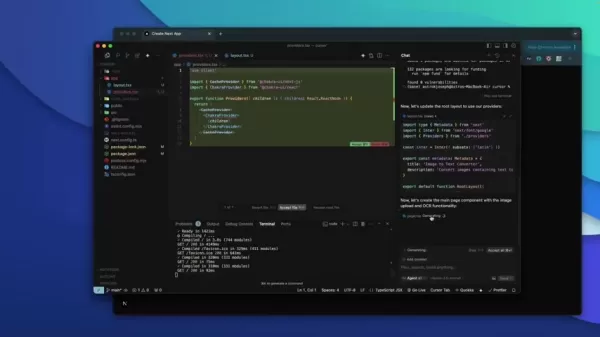Selecting the Best AI Coding Tool for Your Project
The software development landscape is transforming rapidly, with Artificial Intelligence (AI) becoming a key driver. AI coding tools enable developers to write code faster, more accurately, and with greater efficiency. Yet, with numerous options available, picking the right AI coding assistant can feel overwhelming. This guide outlines critical factors to help you choose the ideal AI tool for your project.
Key Points
Explore the main types of AI coding tools: integrated IDEs, code editors, and web-based platforms.
Assess your project’s specific needs and technical requirements.
Examine the integrations each AI tool provides, such as authentication, databases, and payment systems.
Evaluate the learning curve and usability of various AI coding assistants.
Understand the limitations and potential challenges of relying solely on AI for coding.
Understanding the AI Coding Tool Landscape
What Are AI Coding Tools?
AI coding tools use machine learning to support developers in tasks like automating repetitive processes, suggesting code completions, detecting errors, and generating code from natural language prompts.

This speeds up development and allows developers to focus on strategic problem-solving and innovation. Selecting the right tool depends on your desired control level, comfort, and project goals.
Current AI coding tools include:
- Cursor
- Windsurf
- Lovable
- Bolt.new
- V0
- Databutton
- Tempo AI
- Tray AI
- GitHub Copilot
- Klain, and many others.
Two Main Categories of AI Coding Tools
AI coding tools fall into two primary categories:
Group A: Integrated IDEs and Code Editors
These tools cater to developers who prefer traditional coding environments with AI-enhanced features.

They offer greater control and customization. Examples include:
- Cursor
- Windsurf
- Klain (VS Code Extension)
- GitHub Copilot (VS Code Extension)
Group B: Web-Based AI Coding Platforms
These platforms provide a user-friendly, streamlined approach, ideal for beginners or those seeking rapid prototyping and deployment. Examples include:
- Lovable
- Bolt.new
- V0
- Databutton
- Tempo AI
Key Factors to Consider When Choosing an AI Coding Tool
Defining Your Specific Use Case
Start by clearly outlining your project’s needs. Are you developing a complex web app, a simple landing page, or a mobile application? Defining your use case narrows down the best tools for your project.
Key questions to consider:
- What is the application’s primary purpose?
- Which features are critical for functionality?
- Who is the target audience?
- How much customization and control do you need?
Evaluating Features and Integrations
Once your project needs are clear, assess the features and integrations of AI coding tools.

Key considerations include:
- Authentication: Does the tool integrate with providers like Firebase Auth, Supabase Auth, or Clerk?
- Database: Does it support databases like Firestore, Supabase, or Convex?
- Payment Processing: Are payment gateways like Stripe, Paddle, or Lemon Squeezy supported?
- Deployment: How simple is deployment to platforms like Netlify, Vercel, or AWS?
Tech Stack and Coding Proficiency
Your coding expertise and preferred tech stack will shape your tool choice. Experienced React developers may prefer tools like Cursor or Windsurf for greater control.

Beginners may find web-based platforms like Lovable or Databutton more approachable.
Some tools restrict front-end and back-end options. For instance, Databutton uses React for the front end and Python for the back end, while Lovable is React-only. Tempo supports Next.js or Vite React.
Consider your preferred languages and frameworks. Supported languages include:
Coding Tool Language Support Lovable React Databutton React (front end), Python (back end) Tempo AI Next.js, Vite React Bolt.new Svelte, React, Remix, Astro
Getting Started with AI Coding Tools: A Workflow Example
Combining Lovable and Cursor for Optimal Development
A powerful workflow combines web-based platforms like Lovable with IDEs like Cursor.

Use Lovable to prototype and build your app’s initial structure, then export the code to a Git repository. Clone the repository locally and use Cursor for advanced development and customization.
This blends Lovable’s simplicity with Cursor’s flexibility.
Pricing and Availability
Free vs. Paid Options
Most AI coding tools offer free and paid plans. Free plans often have limited features, while paid plans unlock advanced capabilities and remove restrictions. Choose a plan that fits your budget and project needs.
Pros and Cons of Using Lovable.dev for App Development
Pros
Rapid Prototyping: Build and deploy web apps quickly with AI support.
User-Friendly Interface: Simplified workflow for those with limited coding skills.
Third-Party Integrations: Seamless connections with tools like Firebase for databases.
One-Click Publishing: Easy deployment with minimal steps.
Direct Element Editing: Modify designs via the website UI without coding.
Cons
React-Only Projects: Limited to React-based applications.
Limited Customization: Web-based platform restricts control.
Core Features of AI Coding Tools
Enhancing Code Creation with AI
AI coding tools harness artificial intelligence to streamline code generation, offering suggestions, debugging, and even building full applications from a single prompt.
Example Use Cases
Projects Powered by AI Coding Tools
AI coding tools support diverse projects, from crafting landing pages to extracting text from PDFs or building full-stack applications.
FAQ
What Are the Main Benefits of AI Coding Tools?
AI coding tools boost productivity by automating repetitive tasks, minimizing errors, and speeding up development, allowing focus on creative and strategic tasks.
Are AI Coding Tools Suitable for Beginners?
Yes, many AI platforms offer intuitive interfaces and simplified workflows, enabling beginners to prototype and deploy web applications quickly.
What Are the Limitations of AI Coding Tools?
AI tools are not substitutes for skilled developers. They enhance capabilities but over-reliance without coding knowledge can lead to errors and customization limitations.
Related Questions
Which AI Coding Tool Is Right for Me?
The best AI coding tool depends on your needs, skills, and project goals. Consider: Cursor and Windsurf for experienced coders; Lovable for easy web-based coding with Supabase integration; Bolt.new for diverse framework support; V0 for design-focused projects; Databutton for React and Python; Tempo AI for third-party integrations and styling; Tray AI for mobile apps; GitHub Copilot for VS Code users with coding expertise.
Related article
 Uber's QueryGPT: Revolutionizing SQL Query Creation with AI
In the fast-paced, data-centric landscape of modern business, efficiently querying and managing data is vital for organizations of all sizes. SQL, the cornerstone language for database interaction, of
Uber's QueryGPT: Revolutionizing SQL Query Creation with AI
In the fast-paced, data-centric landscape of modern business, efficiently querying and managing data is vital for organizations of all sizes. SQL, the cornerstone language for database interaction, of
 AI-Powered Podcast Tools for Streamlined Content Creation
Producing and refining a podcast can be both demanding and fulfilling. Many podcasters face challenges with time-intensive tasks like removing filler words, crafting compelling show notes, and promoti
AI-Powered Podcast Tools for Streamlined Content Creation
Producing and refining a podcast can be both demanding and fulfilling. Many podcasters face challenges with time-intensive tasks like removing filler words, crafting compelling show notes, and promoti
 Britney Spears' Red Catsuit: A Defining Moment in Pop Fashion
Britney Spears, the reigning pop icon, has consistently captivated audiences with her bold style. Her music videos are not only musical hits but also fashion milestones. This article dives into the un
Comments (0)
0/200
Britney Spears' Red Catsuit: A Defining Moment in Pop Fashion
Britney Spears, the reigning pop icon, has consistently captivated audiences with her bold style. Her music videos are not only musical hits but also fashion milestones. This article dives into the un
Comments (0)
0/200
The software development landscape is transforming rapidly, with Artificial Intelligence (AI) becoming a key driver. AI coding tools enable developers to write code faster, more accurately, and with greater efficiency. Yet, with numerous options available, picking the right AI coding assistant can feel overwhelming. This guide outlines critical factors to help you choose the ideal AI tool for your project.
Key Points
Explore the main types of AI coding tools: integrated IDEs, code editors, and web-based platforms.
Assess your project’s specific needs and technical requirements.
Examine the integrations each AI tool provides, such as authentication, databases, and payment systems.
Evaluate the learning curve and usability of various AI coding assistants.
Understand the limitations and potential challenges of relying solely on AI for coding.
Understanding the AI Coding Tool Landscape
What Are AI Coding Tools?
AI coding tools use machine learning to support developers in tasks like automating repetitive processes, suggesting code completions, detecting errors, and generating code from natural language prompts.

This speeds up development and allows developers to focus on strategic problem-solving and innovation. Selecting the right tool depends on your desired control level, comfort, and project goals.
Current AI coding tools include:
- Cursor
- Windsurf
- Lovable
- Bolt.new
- V0
- Databutton
- Tempo AI
- Tray AI
- GitHub Copilot
- Klain, and many others.
Two Main Categories of AI Coding Tools
AI coding tools fall into two primary categories:
Group A: Integrated IDEs and Code Editors
These tools cater to developers who prefer traditional coding environments with AI-enhanced features.

They offer greater control and customization. Examples include:
- Cursor
- Windsurf
- Klain (VS Code Extension)
- GitHub Copilot (VS Code Extension)
Group B: Web-Based AI Coding Platforms
These platforms provide a user-friendly, streamlined approach, ideal for beginners or those seeking rapid prototyping and deployment. Examples include:
- Lovable
- Bolt.new
- V0
- Databutton
- Tempo AI
Key Factors to Consider When Choosing an AI Coding Tool
Defining Your Specific Use Case
Start by clearly outlining your project’s needs. Are you developing a complex web app, a simple landing page, or a mobile application? Defining your use case narrows down the best tools for your project.
Key questions to consider:
- What is the application’s primary purpose?
- Which features are critical for functionality?
- Who is the target audience?
- How much customization and control do you need?
Evaluating Features and Integrations
Once your project needs are clear, assess the features and integrations of AI coding tools.

Key considerations include:
- Authentication: Does the tool integrate with providers like Firebase Auth, Supabase Auth, or Clerk?
- Database: Does it support databases like Firestore, Supabase, or Convex?
- Payment Processing: Are payment gateways like Stripe, Paddle, or Lemon Squeezy supported?
- Deployment: How simple is deployment to platforms like Netlify, Vercel, or AWS?
Tech Stack and Coding Proficiency
Your coding expertise and preferred tech stack will shape your tool choice. Experienced React developers may prefer tools like Cursor or Windsurf for greater control.

Beginners may find web-based platforms like Lovable or Databutton more approachable.
Some tools restrict front-end and back-end options. For instance, Databutton uses React for the front end and Python for the back end, while Lovable is React-only. Tempo supports Next.js or Vite React.
Consider your preferred languages and frameworks. Supported languages include:
| Coding Tool | Language Support |
|---|---|
| Lovable | React |
| Databutton | React (front end), Python (back end) |
| Tempo AI | Next.js, Vite React |
| Bolt.new | Svelte, React, Remix, Astro |
Getting Started with AI Coding Tools: A Workflow Example
Combining Lovable and Cursor for Optimal Development
A powerful workflow combines web-based platforms like Lovable with IDEs like Cursor.

Use Lovable to prototype and build your app’s initial structure, then export the code to a Git repository. Clone the repository locally and use Cursor for advanced development and customization.
This blends Lovable’s simplicity with Cursor’s flexibility.
Pricing and Availability
Free vs. Paid Options
Most AI coding tools offer free and paid plans. Free plans often have limited features, while paid plans unlock advanced capabilities and remove restrictions. Choose a plan that fits your budget and project needs.
Pros and Cons of Using Lovable.dev for App Development
Pros
Rapid Prototyping: Build and deploy web apps quickly with AI support.
User-Friendly Interface: Simplified workflow for those with limited coding skills.
Third-Party Integrations: Seamless connections with tools like Firebase for databases.
One-Click Publishing: Easy deployment with minimal steps.
Direct Element Editing: Modify designs via the website UI without coding.
Cons
React-Only Projects: Limited to React-based applications.
Limited Customization: Web-based platform restricts control.
Core Features of AI Coding Tools
Enhancing Code Creation with AI
AI coding tools harness artificial intelligence to streamline code generation, offering suggestions, debugging, and even building full applications from a single prompt.
Example Use Cases
Projects Powered by AI Coding Tools
AI coding tools support diverse projects, from crafting landing pages to extracting text from PDFs or building full-stack applications.
FAQ
What Are the Main Benefits of AI Coding Tools?
AI coding tools boost productivity by automating repetitive tasks, minimizing errors, and speeding up development, allowing focus on creative and strategic tasks.
Are AI Coding Tools Suitable for Beginners?
Yes, many AI platforms offer intuitive interfaces and simplified workflows, enabling beginners to prototype and deploy web applications quickly.
What Are the Limitations of AI Coding Tools?
AI tools are not substitutes for skilled developers. They enhance capabilities but over-reliance without coding knowledge can lead to errors and customization limitations.
Related Questions
Which AI Coding Tool Is Right for Me?
The best AI coding tool depends on your needs, skills, and project goals. Consider: Cursor and Windsurf for experienced coders; Lovable for easy web-based coding with Supabase integration; Bolt.new for diverse framework support; V0 for design-focused projects; Databutton for React and Python; Tempo AI for third-party integrations and styling; Tray AI for mobile apps; GitHub Copilot for VS Code users with coding expertise.
 Uber's QueryGPT: Revolutionizing SQL Query Creation with AI
In the fast-paced, data-centric landscape of modern business, efficiently querying and managing data is vital for organizations of all sizes. SQL, the cornerstone language for database interaction, of
Uber's QueryGPT: Revolutionizing SQL Query Creation with AI
In the fast-paced, data-centric landscape of modern business, efficiently querying and managing data is vital for organizations of all sizes. SQL, the cornerstone language for database interaction, of
 AI-Powered Podcast Tools for Streamlined Content Creation
Producing and refining a podcast can be both demanding and fulfilling. Many podcasters face challenges with time-intensive tasks like removing filler words, crafting compelling show notes, and promoti
AI-Powered Podcast Tools for Streamlined Content Creation
Producing and refining a podcast can be both demanding and fulfilling. Many podcasters face challenges with time-intensive tasks like removing filler words, crafting compelling show notes, and promoti
 Britney Spears' Red Catsuit: A Defining Moment in Pop Fashion
Britney Spears, the reigning pop icon, has consistently captivated audiences with her bold style. Her music videos are not only musical hits but also fashion milestones. This article dives into the un
Britney Spears' Red Catsuit: A Defining Moment in Pop Fashion
Britney Spears, the reigning pop icon, has consistently captivated audiences with her bold style. Her music videos are not only musical hits but also fashion milestones. This article dives into the un





























